Hydrothermally Synthesized TiO2 Nanostructures for Electrochemical Detection of H2O2 in Barley (Hordeum vulgare) Under Salt Stress and Remediation with Fe3O4 Nanoparticles
Abstract
1. Introduction
2. Materials and Methods
2.1. Materials
2.2. Hydrothermal Synthesis of TiO2 and Electrode Preparation
2.3. Synthesis and Characterization of Fe3O4 Nanoparticles
2.4. Barley Seedling Cultivation and Sample Preparation
2.5. Genome Template Stability Evaluation
3. Results and Discussions
4. Conclusions
Author Contributions
Funding
Institutional Review Board Statement
Informed Consent Statement
Data Availability Statement
Conflicts of Interest
References
- Panda, S.K.; Gupta, D.; Patel, M.; Vyver, C.V.D.; Koyama, H. Functionality of Reactive Oxygen Species (ROS) in Plants: Toxicity and Control in Poaceae Crops Exposed to Abiotic Stress. Plants 2024, 13, 2071. [Google Scholar] [CrossRef] [PubMed]
- Su, J.; Liu, Y.; Han, F.; Gao, F.; Gan, F.; Huang, K.; Li, Z. ROS, an Important Plant Growth Regulator in Root Growth and Development: Functional Genes and Mechanism. Biology 2024, 13, 1033. [Google Scholar] [CrossRef]
- Guo, W.; Xing, Y.; Luo, X.; Li, F.; Ren, M.; Liang, Y. Reactive Oxygen Species: A Crosslink between Plant and Human Eukaryotic Cell Systems. Int. J. Mol. Sci. 2023, 24, 13052. [Google Scholar] [CrossRef] [PubMed]
- Bardaweel, S.K.; Gul, M.; Alzweiri, M.; Ishaqat, A.; ALSalamat, H.A.; Bashatwah, R.M. Reactive Oxygen Species: The Dual Role in Physiological and Pathological Conditions of the Human Body. Eurasian J. Med. 2018, 50, 193–201. [Google Scholar] [CrossRef] [PubMed]
- Hasanuzzaman, M.; Bhuyan, M.H.M.B.; Zulfiqar, F.; Raza, A.; Mohsin, S.M.; Mahmud, J.A.; Fujita, M.; Fotopoulos, V. Reactive Oxygen Species and Antioxidant Defense in Plants under Abiotic Stress: Revisiting the Crucial Role of a Universal Defense Regulator. Antioxidants 2020, 9, 681. [Google Scholar] [CrossRef]
- Yoshikawa, T.; You, F. Oxidative Stress and Bio-Regulation. Int. J. Mol. Sci. 2024, 25, 3360. [Google Scholar] [CrossRef]
- Chaki, M.; Begara-Morales, J.C.; Barroso, J.B. Oxidative Stress in Plants. Antioxidants 2020, 9, 481. [Google Scholar] [CrossRef]
- He, Q.; Feng, W.; Chen, X.; Xu, Y.; Zhou, J.; Li, J.; Xu, P.; Tang, Y. H2O2-Induced Oxidative Stress Responses in Eriocheir sinensis: Antioxidant Defense and Immune Gene Expression Dynamics. Antioxidants 2024, 13, 524. [Google Scholar] [CrossRef]
- Zhong, Y.; Ma, T.; Fu, Z.; Chen, A.; Yu, J.; Huang, Y.; Fu, J. Effects of Hydrogen Peroxide-Induced Oxidative Stress on Intestinal Morphology, Redox Status, and Related Molecules in Squabs. Animals 2023, 13, 749. [Google Scholar] [CrossRef]
- Rahman, M.; Asaeda, T.; Fukahori, K.; Imamura, F.; Nohara, A.; Matsubayashi, M. Hydrogen Peroxide Measurement Can Be Used to Monitor Plant Oxidative Stress Rapidly Using Modified Ferrous Oxidation Xylenol Orange and Titanium Sulfate Assay Correlation. Int. J. Plant Biol. 2023, 14, 546–557. [Google Scholar] [CrossRef]
- Ransy, C.; Vaz, C.; Lombès, A.; Bouillaud, F. Use of H2O2 to Cause Oxidative Stress, the Catalase Issue. Int. J. Mol. Sci. 2020, 21, 9149. [Google Scholar] [CrossRef] [PubMed]
- de França, V.C.P.L.A.; Campos, W.F.; Dobbss, L.B. Dynamics of Salt Stress in Plants: Effects and Plant Responses. Curr. Opin. J. Res. Rev. 2023, 4, 000593. [Google Scholar]
- Balasubramaniam, T.; Shen, G.; Esmaeili, N.; Zhang, H. Plants’ Response Mechanisms to Salinity Stress. Plants 2023, 12, 2253. [Google Scholar] [CrossRef] [PubMed]
- Bhat, M.A.; Jamshieed, S.; Mujib, A.; Azooz, M.M.; Mahmooduzzafar; Aslam, J.; Ahmad, P. Plant Tissue Culture: A Useful Measure for the Screening of Salt Tolerance in Plants. In Salt Stress in Plants; Ahmad, P., Azooz, M.M., Prasad, M.N.V., Eds.; Springer: New York, NY, USA, 2013; pp. 465–495. [Google Scholar] [CrossRef]
- Liu, C.; Jiang, X.; Yuan, Z. Plant Responses and Adaptations to Salt Stress: A Review. Horticulturae 2024, 10, 1221. [Google Scholar] [CrossRef]
- Ahanger, M.A.; Tomar, N.S.; Tittal, M.; Argal, S.; Agarwal, R.M. Plant growth under water/salt stress: ROS production; antioxidants and significance of added potassium under such conditions. Physiol. Mol. Biol. Plants 2017, 23, 731–744. [Google Scholar] [CrossRef]
- Kesawat, M.S.; Satheesh, N.; Kherawat, B.S.; Kumar, A.; Kim, H.-U.; Chung, S.-M.; Kumar, M. Regulation of Reactive Oxygen Species during Salt Stress in Plants and Their Crosstalk with Other Signaling Molecules—Current Perspectives and Future Directions. Plants 2023, 12, 864. [Google Scholar] [CrossRef]
- Akyol, T.Y.; Yilmaz, O.; Uzilday, B.; Uzilday, R.Ö.; Turkan, İ. Plant response to salinity: An analysis of ROS formation, signaling, and antioxidant defense. Turk. J. Bot. 2020, 44, 1. [Google Scholar] [CrossRef]
- Atta, K.; Mondal, S.; Gorai, S.; Singh, A.P.; Kumari, A.; Ghosh, T.; Roy, A.; Hembram, S.; Gaikwad, D.J.; Mondal, S.; et al. Impacts of salinity stress on crop plants: Improving salt tolerance through genetic and molecular dissection. Front. Plant Sci. 2023, 14, 1241736. [Google Scholar] [CrossRef]
- Zvanarou, S.; Vágnerová, R.; Mackievic, V.; Usnich, S.; Smolich, I.; Sokolik, A.; Yu, M.; Huang, X.; Angelis, K.J.; Demidchik, V. Salt Stress Triggers Generation of Oxygen Free Radicals and DNA Damage in Moss Physcomitrella patens. Environ. Exp. Bot. 2020, 180, 104236. [Google Scholar] [CrossRef]
- Skorupa, M.; Szczepanek, J.; Mazur, J.; Domagalski, K.; Tretyn, A.; Tyburski, J. Salt stress and salt shock differently affect DNA methylation in salt-responsive genes in sugar beet and its wild, halophytic ancestor. PLoS ONE 2021, 16, e0251675. [Google Scholar] [CrossRef]
- Rajput, V.D.; Harish; Singh, R.K.; Verma, K.K.; Sharma, L.; Quiroz-Figueroa, F.R.; Meena, M.; Gour, V.S.; Minkina, T.; Sushkova, S.; et al. Recent Developments in Enzymatic Antioxidant Defence Mechanism in Plants with Special Reference to Abiotic Stress. Biology 2021, 10, 267. [Google Scholar] [CrossRef] [PubMed]
- Ghorbel, M.; Olayen, W.; Brini, F. Roles of Enzymatic Antioxidants in Stress Response and Signaling in Plants. In Defense-Related Enzymes in Plants; Upadhyay, S.K., Ed.; Academic Press: Cambridge, MA, USA, 2024; pp. 413–468. [Google Scholar] [CrossRef]
- Porwal, P.; Sonkar, S.; Singh, A.K. Plant Stress Enzymes Nanobiotechnology. In Nanobiotechnology: Mitigation of Abiotic Stress in Plants; Al-Khayri, J.M., Ansari, M.I., Singh, A.K., Eds.; Springer Nature: Cham, Switzerland, 2021; pp. 327–348. [Google Scholar] [CrossRef]
- Khairallah, Y.R.; Houri, T.; Osta, B.; Romanos, D.M.; Haddad, G.R. Responses of Antioxidant Enzymes to Oxidative Stress in the Floral Species Drimia Maritime. Adv. Environ. Stud. 2022, 6, 474–478. [Google Scholar] [CrossRef]
- Waśkiewicz, A.; Beszterda, M.; Goliński, P. Nonenzymatic Antioxidants in Plants. In Oxidative Damage to Plants: Antioxidant Networks and Signaling; Ahmad, P., Ed.; Academic Press: Cambridge, MA, USA, 2014; pp. 201–234. [Google Scholar] [CrossRef]
- Rudenko, N.N.; Vetoshkina, D.V.; Marenkova, T.V.; Borisova-Mubarakshina, M.M. Antioxidants of Non-Enzymatic Nature: Their Function in Higher Plant Cells and the Ways of Boosting Their Biosynthesis. Antioxidants 2023, 12, 2014. [Google Scholar] [CrossRef]
- Chaffai, R.; Ganesan, M.; Cherif, A. Signaling Pathways in Plant Responses to Abiotic Stress. In Plant Adaptation to Abiotic Stress: From Signaling Pathways and Microbiomes to Molecular Mechanisms; Springer: Singapore, 2024; pp. 209–247. [Google Scholar] [CrossRef]
- Manepalli, S.B.; Tomar, S.; Gaikwad, D.J.; Maitra, S. Abiotic stress signaling in plants and transgenic technology as a triumph: A review. J. Appl. Biol. Biotech. 2022, 10, 5–13. [Google Scholar] [CrossRef]
- Caesar, T. Analyzing Molecular Pathways in Plant Stress Responses: A Biochemical Perspective. J. Plant Biochem. Physiol. 2024, 12, 1000315. [Google Scholar]
- Zhu, J.-K. Abiotic Stress Signaling and Responses in Plants. Cell 2016, 167, 313–324. [Google Scholar] [CrossRef]
- Daré, R.G.; Lautenschlager, S.O.S. Nanoparticles with Antioxidant Activity. Antioxidants 2025, 14, 221. [Google Scholar] [CrossRef] [PubMed]
- Sachdev, S.; Ahmad, S. Role of Nanomaterials in Regulating Oxidative Stress in Plants. In Nanobiotechnology: Mitigation of Abiotic Stress in Plants; Al-Khayri, J.M., Ansari, M.I., Singh, A.K., Eds.; Springer: Cham, Switzerland, 2021; pp. 305–326. [Google Scholar] [CrossRef]
- Nongbet, A.; Panda, J.; Mohanta, Y.K.; Chakrabartty, I.; Shamim, M.Z.; Mohanta, T.K. Role of Nanoparticles to Protect Plants from Abiotic Stress by Scavenging Reactive Oxygen Species. In Nanotechnology for Abiotic Stress Tolerance and Management in Crop Plants; Pudake, R.N., Ravi Mani Tripathi, R.M., Gill, S.S., Eds.; Academic Press: Cambridge, MA, USA, 2024; pp. 95–114. [Google Scholar] [CrossRef]
- Sang, Y.; Zhang, L.; Li, Y.F.; Chen, L.Q.; Xu, J.L.; Huang, C.Z. A Visual Detection of Hydrogen Peroxide on the Basis of Fenton Reaction with Gold Nanoparticles. Anal. Chim. Acta 2010, 659, 224–228. [Google Scholar] [CrossRef]
- Wu, M.; Guo, X.; Cao, Y.; Yu, H.; Hu, Z.; Yang, Y.; Yao, T.; Wu, J. Cascading H2O2 Photosynthesis and Fenton Reaction for Self-Sustaining Pollutant Degradation. Chem. Eng. J. 2024, 489, 151091. [Google Scholar] [CrossRef]
- Xiao, J.; Guo, S.; Wang, D.; An, Q. Fenton-Like Reaction: Recent Advances and New Trends. Chem. Eur. J. 2024, 30, e202304337. [Google Scholar] [CrossRef]
- Konate, A.; He, X.; Zhang, Z.; Ma, Y.; Zhang, P.; Alugongo, G.M.; Rui, Y. Magnetic (Fe3O4) Nanoparticles Reduce Heavy Metals Uptake and Mitigate Their Toxicity in Wheat Seedling. Sustainability 2017, 9, 790. [Google Scholar] [CrossRef]
- Kicheeva, A.G.; Sushko, E.S.; Bondarenko, L.S.; Kydralieva, K.A.; Pankratov, D.A.; Tropskaya, N.S.; Dzeranov, A.A.; Dzhardimalieva, G.I.; Zarrelli, M.; Kudryasheva, N.S. Functionalized Magnetite Nanoparticles: Characterization, Bioeffects, and Role of Reactive Oxygen Species in Unicellular and Enzymatic Systems. Int. J. Mol. Sci. 2023, 24, 1133. [Google Scholar] [CrossRef] [PubMed]
- Gupta, N.; Singh, P.M.; Sagar, V.; Pandya, A.; Chinnappa, M.; Kumar, R.; Bahadur, A. Seed Priming with ZnO and Fe3O4 Nanoparticles Alleviate the Lead Toxicity in Basella alba L. through Reduced Lead Uptake and Regulation of ROS. Plants 2022, 11, 2227. [Google Scholar] [CrossRef]
- Zhou, M.; Sun, H.; Chen, S.; Yang, M.; Dong, R.; Yang, X.; Zang, L. Chemosensors for H2O2 Detection: Principles, Active Materials, and Applications. Chemosensors 2025, 13, 54. [Google Scholar] [CrossRef]
- Hsu, C.-C.; Lo, Y.-R.; Lin, Y.-C.; Shi, Y.-C.; Li, P.-L. A Spectrometric Method for Hydrogen Peroxide Concentration Measurement with a Reusable and Cost-Efficient Sensor. Sensors 2015, 15, 25716–25729. [Google Scholar] [CrossRef]
- Pouri, H.; Panta, R.; Bharathan, P.; Fang, J.; Zhang, J. Advances in Nanostructured Fluorescence Sensors for H2O2 Detection: Current Status and Future Direction. Micro 2025, 5, 15. [Google Scholar] [CrossRef]
- Haddad Irani-nezhad, M.; Khataee, A.; Hassanzadeh, J.; Orooji, Y. A Chemiluminescent Method for the Detection of H2O2 and Glucose Based on Intrinsic Peroxidase-Like Activity of WS2 Quantum Dots. Molecules 2019, 24, 689. [Google Scholar] [CrossRef]
- Sohrabi, H.; Maleki, F.; Khaaki, P.; Kadhom, M.; Kudaibergenov, N.; Khataee, A. Electrochemical-Based Sensing Platforms for Detection of Glucose and H2O2 by Porous Metal–Organic Frameworks: A Review of Status and Prospects. Biosensors 2023, 13, 347. [Google Scholar] [CrossRef]
- Ahmad, T.; Iqbal, A.; Halim, S.A.; Uddin, J.; Khan, A.; El Deeb, S.; Al-Harrasi, A. Recent Advances in Electrochemical Sensing of Hydrogen Peroxide (H2O2) Released from Cancer Cells. Nanomaterials 2022, 12, 1475. [Google Scholar] [CrossRef]
- Song, R.-M.; Li, Z.-H.; Wei, P.-J.; Zhao, X.-L.; Chen, C.; Zhu, Z.-G. Flexible Hydrogen Peroxide Sensors Based on Platinum Modified Free-Standing Reduced Graphene Oxide Paper. Appl. Sci. 2018, 8, 848. [Google Scholar] [CrossRef]
- Zhao, Z.; Zharnikov, M. Gold Nanoparticle-Loaded Porous Poly(ethylene glycol) Nanosheets for Electrochemical Detection of H2O2. Nanomaterials 2023, 13, 3137. [Google Scholar] [CrossRef] [PubMed]
- Molahalli, V.; Sharma, A.; Shetty, A.; Hegde, G. SnO2QDs Deposited on GO/PPy-Modified Glassy Carbon Electrode for Efficient Electrochemical Hydrogen Peroxide Sensor. Biosensors 2022, 12, 983. [Google Scholar] [CrossRef] [PubMed]
- Sobahi, N.; Imran, M.; Khan, M.E.; Mohammad, A.; Alam, M.M.; Yoon, T.; Mehedi, I.M.; Hussain, M.A.; Abdulaal, M.J.; Jiman, A.A. Electrochemical Sensing of H2O2 by Employing a Flexible Fe3O4/Graphene/Carbon Cloth as Working Electrode. Materials 2023, 16, 2770. [Google Scholar] [CrossRef]
- Guan, Y.; Xu, F.; Sun, L.; Luo, Y.; Cheng, R.; Zou, Y.; Liao, L.; Cao, Z. Hydrogen Peroxide Electrochemical Sensor Based on Ag/Cu Bimetallic Nanoparticles Modified on Polypyrrole. Sensors 2023, 23, 8536. [Google Scholar] [CrossRef] [PubMed]
- Guerrero, L.A.; Fernández, L.; González, G.; Montero-Jiménez, M.; Uribe, R.; Díaz Barrios, A.; Espinoza-Montero, P.J. Peroxide Electrochemical Sensor and Biosensor Based on Nanocomposite of TiO2 Nanoparticle/Multi-Walled Carbon Nanotube Modified Glassy Carbon Electrode. Nanomaterials 2020, 10, 64. [Google Scholar] [CrossRef] [PubMed]
- Zhang, Y.; Offenhäusser, A.; Mourzina, Y. A Study on the Mechanism and Properties of a Self-Powered H2O2 Electrochemical Sensor Based on a Fuel Cell Configuration with FePc and Graphene Cathode Catalyst Materials. Biosensors 2024, 14, 290. [Google Scholar] [CrossRef]
- Wang, S.; Zhang, T.; Zhu, X.; Zu, S.; Xie, Z.; Lu, X.; Zhang, M.; Song, L.; Jin, Y. Metal–Organic Frameworks for Electrocatalytic Sensing of Hydrogen Peroxide. Molecules 2022, 27, 4571. [Google Scholar] [CrossRef]
- Trujillo, R.M.; Barraza, D.E.; Zamora, M.L.; Cattani-Scholz, A.; Madrid, R.E. Nanostructures in Hydrogen Peroxide Sensing. Sensors 2021, 21, 2204. [Google Scholar] [CrossRef]
- Antonacci, A.; Arduini, F.; Moscone, D.; Palleschi, G.; Scognamiglio, V. Nanostructured (Bio)sensors for smart agriculture. Trends Anal. Chem. 2018, 98, 95–103. [Google Scholar] [CrossRef]
- Keles, G.; Sifa Ataman, E.; Taskin, S.B.; Polatoglu, İ.; Kurbanoglu, S. Nanostructured Metal Oxide-Based Electrochemical Biosensors in Medical Diagnosis. Biosensors 2024, 14, 238. [Google Scholar] [CrossRef]
- Sledevskis, E.; Krasovska, M.; Gerbreders, V.; Mihailova, I.; Keviss, J.; Mizers, V.; Bulanovs, A. Impact of ZnO Nanostructure Morphology on Electrochemical Sensing Performance for Lead Ion Detection in Real Water Samples. Chemosensors 2025, 13, 62. [Google Scholar] [CrossRef]
- Frías Márquez, D.M.; Méndez González, J.Á.; López González, R.; García Mendoza, C.; Tzompantzi Morales, F.J.; Quintana Owen, P.; Alvarez Lemus, M.A. Titanium Dioxide 1D Nanostructures as Photocatalysts for Degradation and Removal of Pollutants in Water. Catalysts 2024, 14, 896. [Google Scholar] [CrossRef]
- Gerbreders, V.; Krasovska, M.; Sledevskis, E.; Mihailova, I.; Mizers, V.; Keviss, J.; Bulanovs, A. Enhancing Salt Stress Tolerance in Rye with ZnO Nanoparticles: Detecting H2O2 as a Stress Biomarker by Nanostructured NiO Electrochemical Sensor. Crystals 2024, 14, 423. [Google Scholar] [CrossRef]
- Gerbreders, V.; Krasovska, M.; Sledevskis, E.; Mihailova, I.; Mizers, V. Co3O4 Nanostructured Sensor for Electrochemical Detection of H2O2 as a Stress Biomarker in Barley: Fe3O4 Nanoparticles-Mediated Enhancement of Salt Stress Tolerance. Micromachines 2024, 15, 311. [Google Scholar] [CrossRef]
- Mizers, V.; Gerbreders, V.; Krasovska, M.; Sledevskis, E.; Mihailova, I.; Ogurcovs, A.; Bulanovs, A.; Gerbreders, A. Non-Enzymatic Co3O4 Nanostucture-based Electrochemical Sensor for H2O2 Detection. Latv. J. Phys. Tech. Sci. 2023, 60, 63–84. [Google Scholar] [CrossRef]
- Bertel, L.; Miranda, D.A.; García-Martín, J.M. Nanostructured Titanium Dioxide Surfaces for Electrochemical Biosensing. Sensors 2021, 21, 6167. [Google Scholar] [CrossRef]
- Saeed, A.A.; Abbas, M.N.; El-Hawary, W.F.; Issa, Y.M.; Singh, B. A Core–Shell Au@TiO2 and Multi-Walled Carbon Nanotube-Based Sensor for the Electroanalytical Determination of H2O2 in Human Blood Serum and Saliva. Biosensors 2022, 12, 778. [Google Scholar] [CrossRef] [PubMed]
- de Oliveira, R.H.; Gonçalves, D.A.; dos Reis, D.D. TiO2/MWCNT/Nafion-Modified Glassy Carbon Electrode as a Sensitive Voltammetric Sensor for the Determination of Hydrogen Peroxide. Sensors 2023, 23, 7732. [Google Scholar] [CrossRef]
- Mhadhbi, M.; Abderazzak, H.; Avar, B. Synthesis and Properties of Titanium Dioxide Nanoparticles. In Updates on Titanium Dioxide; Bejaoui, B., Ed.; IntechOpen: London, UK, 2023. [Google Scholar] [CrossRef]
- Sekino, T. Synthesis and Applications of Titanium Oxide Nanotubes. In Inorganic and Metallic Nanotubular Materials; Kijima, T., Ed.; Springer: Berlin/Heidelberg, Germany, 2010; pp. 17–32. [Google Scholar] [CrossRef]
- López Zavala, M.Á.; Lozano Morales, S.A.; Ávila-Santos, M. Synthesis of Stable TiO2 Nanotubes: Effect of Hydrothermal Treatment, Acid Washing and Annealing Temperature. Heliyon 2017, 3, e00456. [Google Scholar] [CrossRef]
- Roy, P.; Berger, S.; Schmuki, P. TiO2 Nanotubes: Synthesis and Applications. Angew. Chem. Int. Ed. 2011, 50, 2904–2939. [Google Scholar] [CrossRef]
- Hasanah, E.U.; Kustiningsih, I.; Slamet, S.; Baig, M.A.A. Recent Development and Application of TiO2 Nanotubes Photocatalytic Activity for Degradation Synthetic Dyes—A Review. J. Rekayasa Kimia Lingkungan 2021, 16, 52–67. [Google Scholar] [CrossRef]
- Wahyuni, S.; Kartini, I.; Kadarwati, S. The Properties and Activity of TiO2-Based Nanorods as an Anti-Fouling Agent and a Photocatalyst. Bull. Chem. React. Eng. Catal. 2024, 19, 47–60. [Google Scholar] [CrossRef]
- Hosseini, S.N.; Chen, X.; Baesjou, P.J.; Imhof, A.; van Blaaderen, A. Synthesis and Characterization of Anatase TiO2 Nanorods: Insights from Nanorods’ Formation and Self-Assembly. Appl. Sci. 2022, 12, 1614. [Google Scholar] [CrossRef]
- Suryana, R.; Sehati; Kusumandari, K. Synthesis of Nanorods Titanium Dioxide via Anodic Alumina Membrane Template and Their Applications in Dye-Sensitized Solar Cells. J. Phys. Conf. Ser. 2016, 739, 012108. [Google Scholar] [CrossRef]
- Chi, B.; Victorio, E.S.; Jin, T. Synthesis of TiO2-Based Nanotube on Ti Substrate by Hydrothermal Treatment. J. Nanosci. Nanotechnol. 2007, 7, 668–672. [Google Scholar] [CrossRef] [PubMed]
- Abdullah, M.; Kamarudin, S.K. Influence of Highly Concentrated Sodium Hydroxide (NaOH) Towards Formation of Highly Ordered TiO2 Nanotubes (TNT) Structure. Malays. J. Anal. Sci. 2016, 20, 1405–1412. [Google Scholar] [CrossRef]
- Victoria Dimas, B.; Hernández Pérez, I.; Garibay Febles, V.; Díaz Barriga Arceo, L.; Suárez Parra, R.; Rivera Olvera, J.N.; Luna Paz, R.; Melo Máximo, D.V.; González Reyes, L. Atomic-Scale Investigation on the Evolution of Tio2-Anatase Prepared by a Sonochemical Route and Treated with NaOH. Materials 2020, 13, 685. [Google Scholar] [CrossRef]
- Pattanayak, D.K.; Yamaguchi, S.; Matsushita, T.; Kokubo, T. Nanostructured Positively Charged Bioactive TiO2 Layer Formed on Ti Metal by NaOH, Acid and Heat Treatments. J. Mater. Sci. Mater. Med. 2011, 22, 1803–1812. [Google Scholar] [CrossRef]
- Kokina, I.; Plaksenkova, I.; Galek, R.; Jermaļonoka, M.; Kirilova, E.; Gerbreders, V.; Krasovska, M.; Sledevskis, E. Genotoxic Evaluation of Fe3O4 Nanoparticles in Different Three Barley (Hordeum vulgare L.) Genotypes to Explore the Stress-Resistant Molecules. Molecules 2021, 26, 6710. [Google Scholar] [CrossRef]
- Atienzar, F.A.; Conradi, M.; Evenden, A.J.; Jha, A.N.; Depledge, M.H. Qualitative assessment of genotoxicity using random amplified polymorphic DNA: Comparison of genomic template stability with key fitness parameters in Daphnia magna exposed to benzo[a]pyrene. Environ. Toxicol. Chem. 1999, 18, 2275–2282. [Google Scholar] [CrossRef]
- Ozyigit, I.I.; Arda, L.; Yalcin, B.; Yalcin, I.E.; Ucar, B.; Hocaoglu-Ozyigit, A. Lemna minor, a hyperaccumulator shows elevated levels of Cd accumulation and genomic template stability in binary application of Cd and Ni: A physiological and genetic approach. Int. J. Phytoremediat. 2021, 23, 1255–1269. [Google Scholar] [CrossRef]
- Silprasit, K.; Ngamniyom, A.; Kerksakul, P.; Thumajitsakul, S. Using Morphology and Genomic Template Stability (GTS) to Track Herbicide Effect on Some Submersed Aquatic Plants. Appl. Environ. Res. 2016, 38, 75–85. [Google Scholar] [CrossRef]
- Mihailova, I.; Gerbreders, V.; Krasovska, M.; Sledevskis, E.; Mizers, V.; Keviss, J.; Bulanovs, A.; Ogurcovs, A. A Non-Enzymatic Electrochemical Hydrogen Peroxide Sensor Based on Copper Oxide Nanostructures. Beilstein J. Nanotechnol. 2022, 13, 424–436. [Google Scholar] [CrossRef] [PubMed]
- Mihailova, I.; Krasovska, M.; Sledevskis, E.; Gerbreders, V.; Mizers, V.; Ogurcovs, A. Assessment of Oxidative Stress by Detection of H2O2 in Rye Samples Using a CuO- and Co3O4-Nanostructure-Based Electrochemical Sensor. Chemosensors 2023, 11, 532. [Google Scholar] [CrossRef]
- Walimbe, P.D.; Kumar, R.; Shringi, A.K.; Keelson, O.; Ouma, H.A.; Yan, F. Electrochemical Detection of H2O2 Using Bi2O3/Bi2O2Se Nanocomposites. Nanomaterials 2024, 14, 1592. [Google Scholar] [CrossRef]
- Rusu, M.M.; Fort, C.I.; Vulpoi, A.; Barbu-Tudoran, L.; Baia, M.; Cotet, L.C.; Baia, L. Ultrasensitive Electroanalytical Detection of Pb2+ and H2O2 Using Bi and Fe—Based Nanoparticles Embedded into Porous Carbon Xerogel—The Influence of Nanocomposite Pyrolysis Temperatures. Gels 2023, 9, 868. [Google Scholar] [CrossRef]
- Ray, C.; Dutta, S.; Roy, A.; Sahoo, R.; Pal, T. Redox Mediated Synthesis of Hierarchical Bi2O3/MnO2 Nanoflowers: A Non-Enzymatic Hydrogen Peroxide Electrochemical Sensor. Dalton Trans. 2016, 45, 4780–4790. [Google Scholar] [CrossRef]
- Failla, V.; Ferlazzo, A.; Abbate, V.; Neri, G.; Saccullo, E.; Gulino, A.; Rescifina, A.; Patamia, V.; Floresta, G. THP as a sensor for the electrochemical detection of H2O2. Bioorg. Chem. 2024, 152, 107721. [Google Scholar] [CrossRef]
- Çelebi, M.S.; Kara, S.K. Non-enzymatic hydrogen peroxide sensor based on palladium-decorated poly(thionine) modified glassy carbon electrode. J. Chin. Chem. Soc. 2024, 71, 482–492. [Google Scholar] [CrossRef]
- Aparicio-Martínez, E.; Ibarra, A.; Estrada-Moreno, I.A.; Velia Osuna, V.; Rocio, B.; Dominguez, R.B. Flexible electrochemical sensor based on laser scribed Graphene/Ag nanoparticles for non-enzymatic hydrogen peroxide detection. Sens. Actuators B Chem. 2019, 301, 127101. [Google Scholar] [CrossRef]
- Li, P.; Chen, L.; Yao, Q.; Khan, H.U.; Chen, D.; Guo, Y. Graphene supported gold hollow sphere for real-time electrochemical detection of H2O2 released from cells. J. Electroanal. Chem. 2024, 958, 118153. [Google Scholar] [CrossRef]
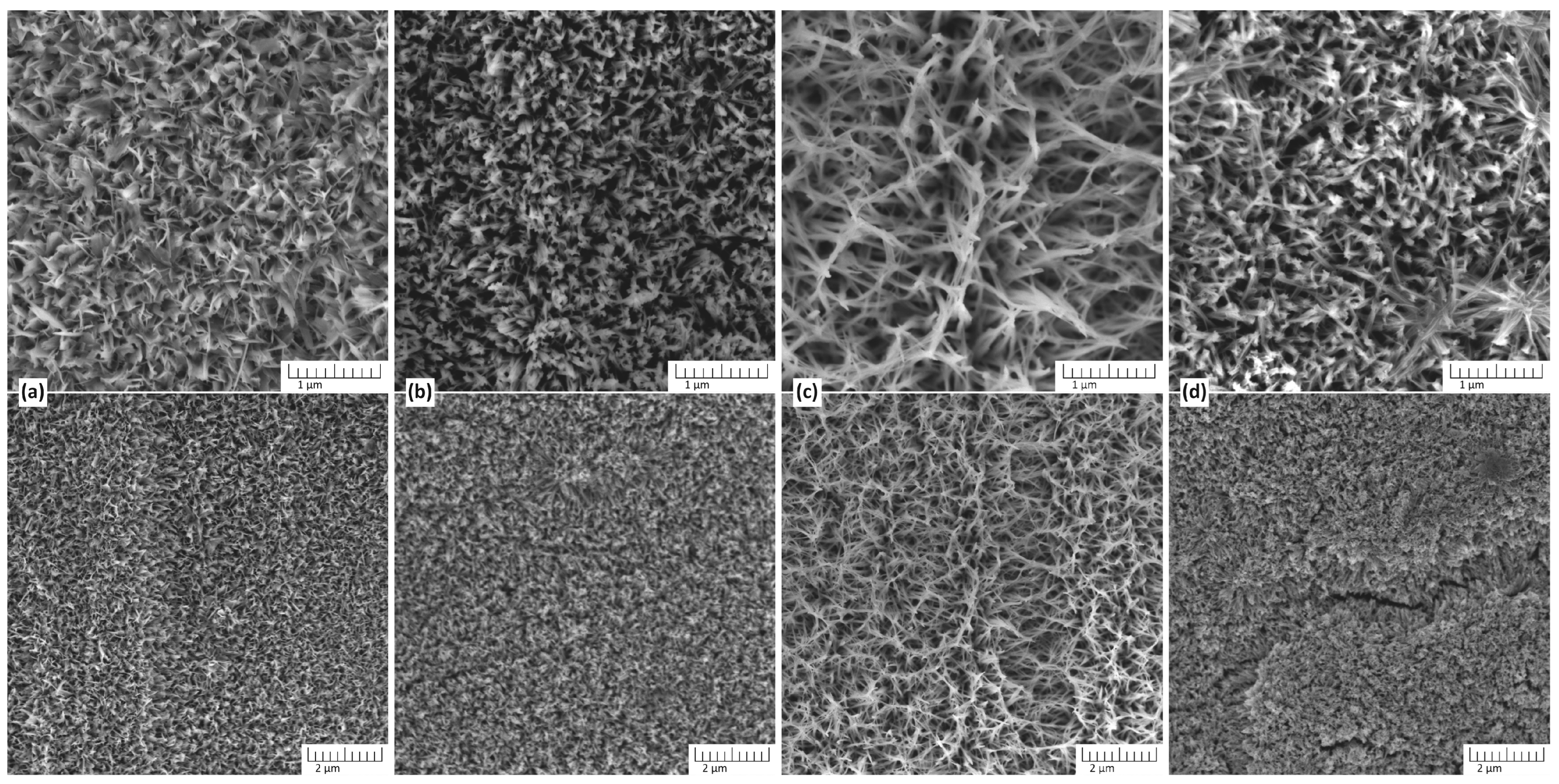
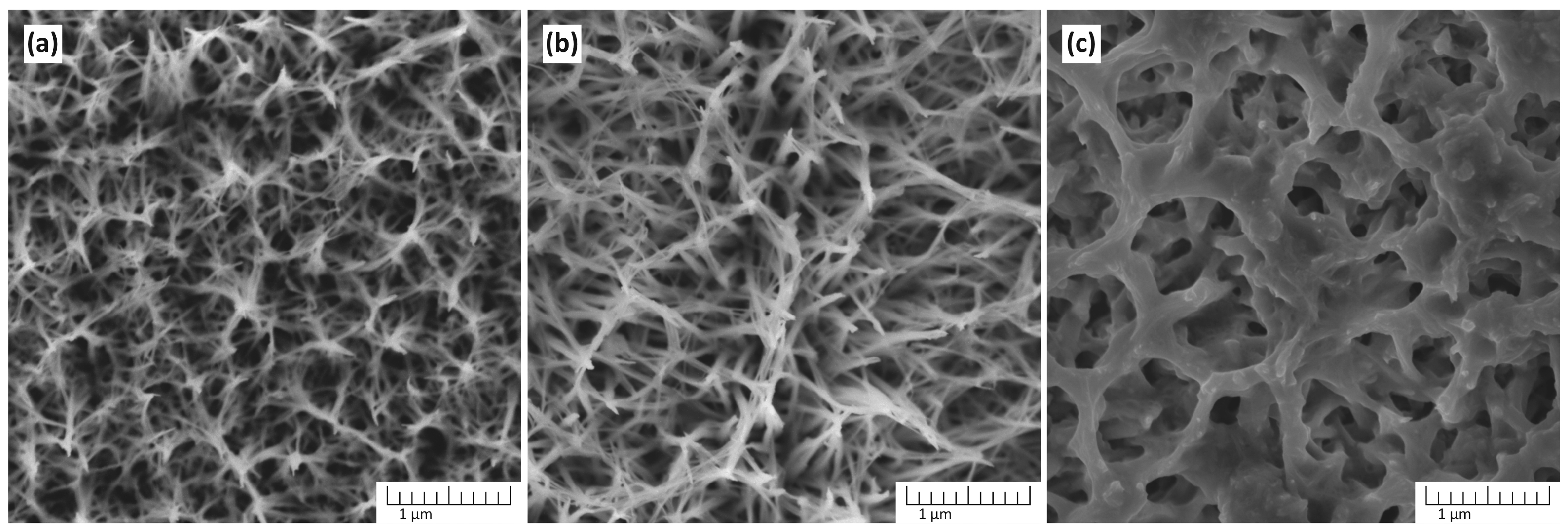
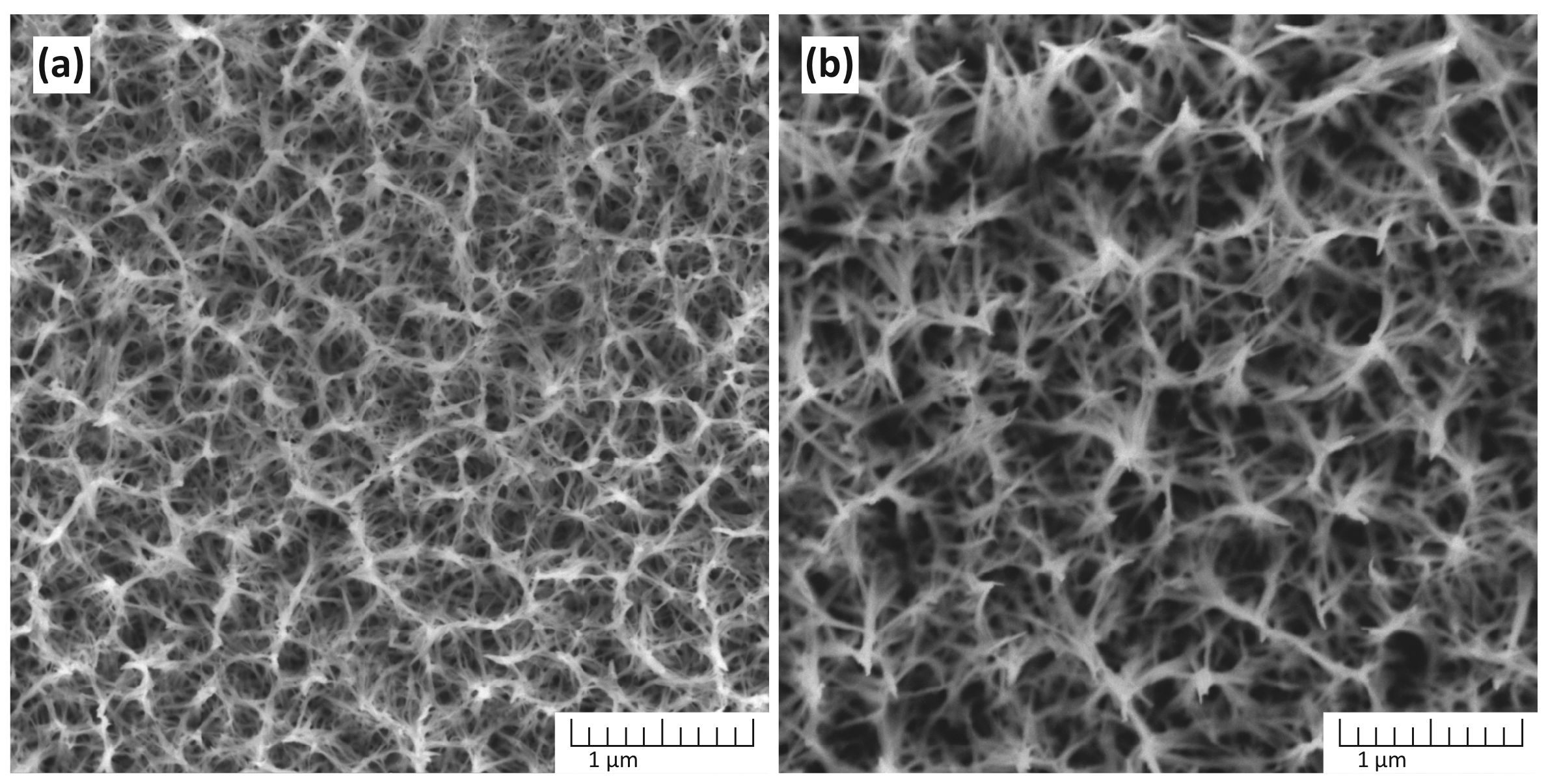


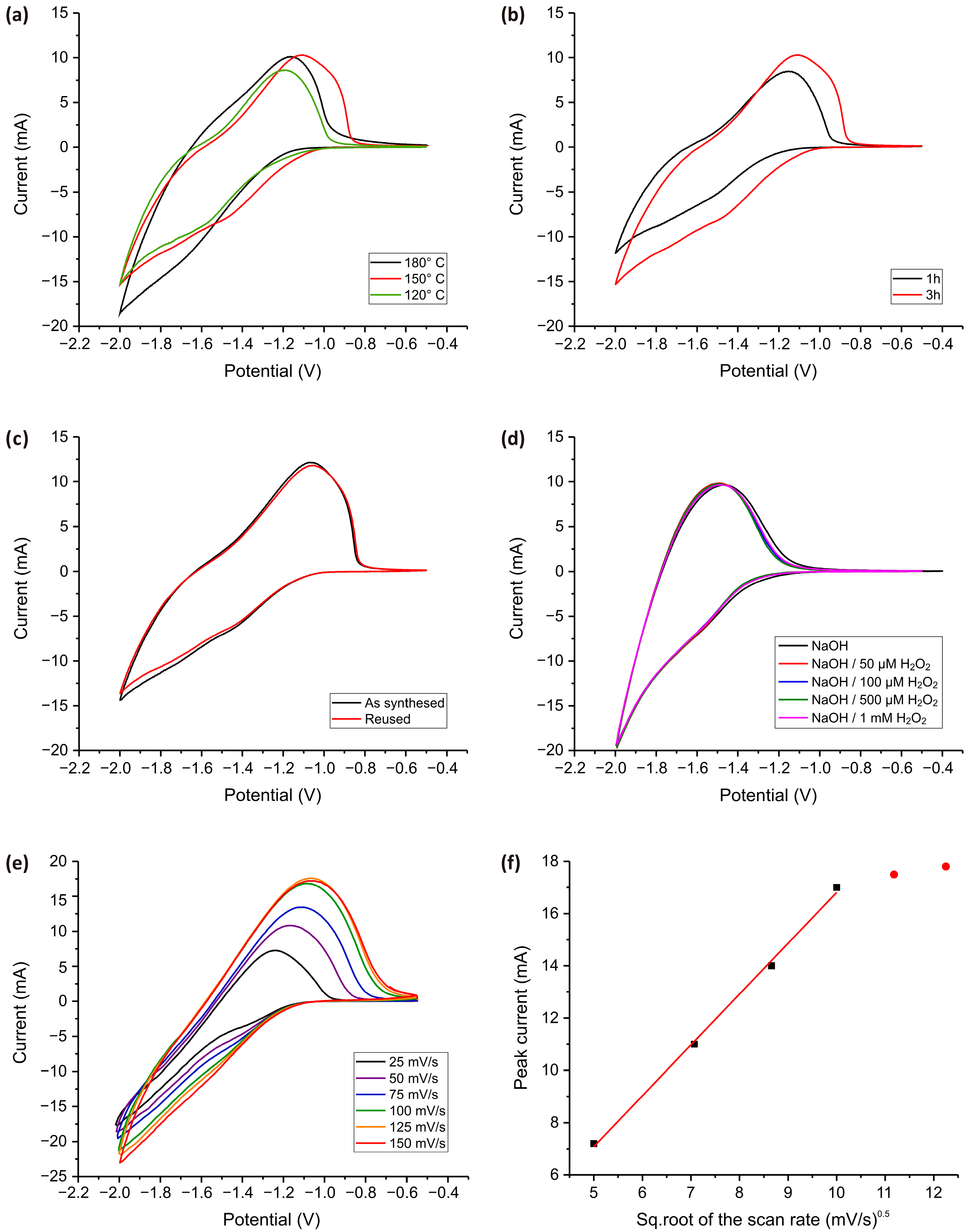
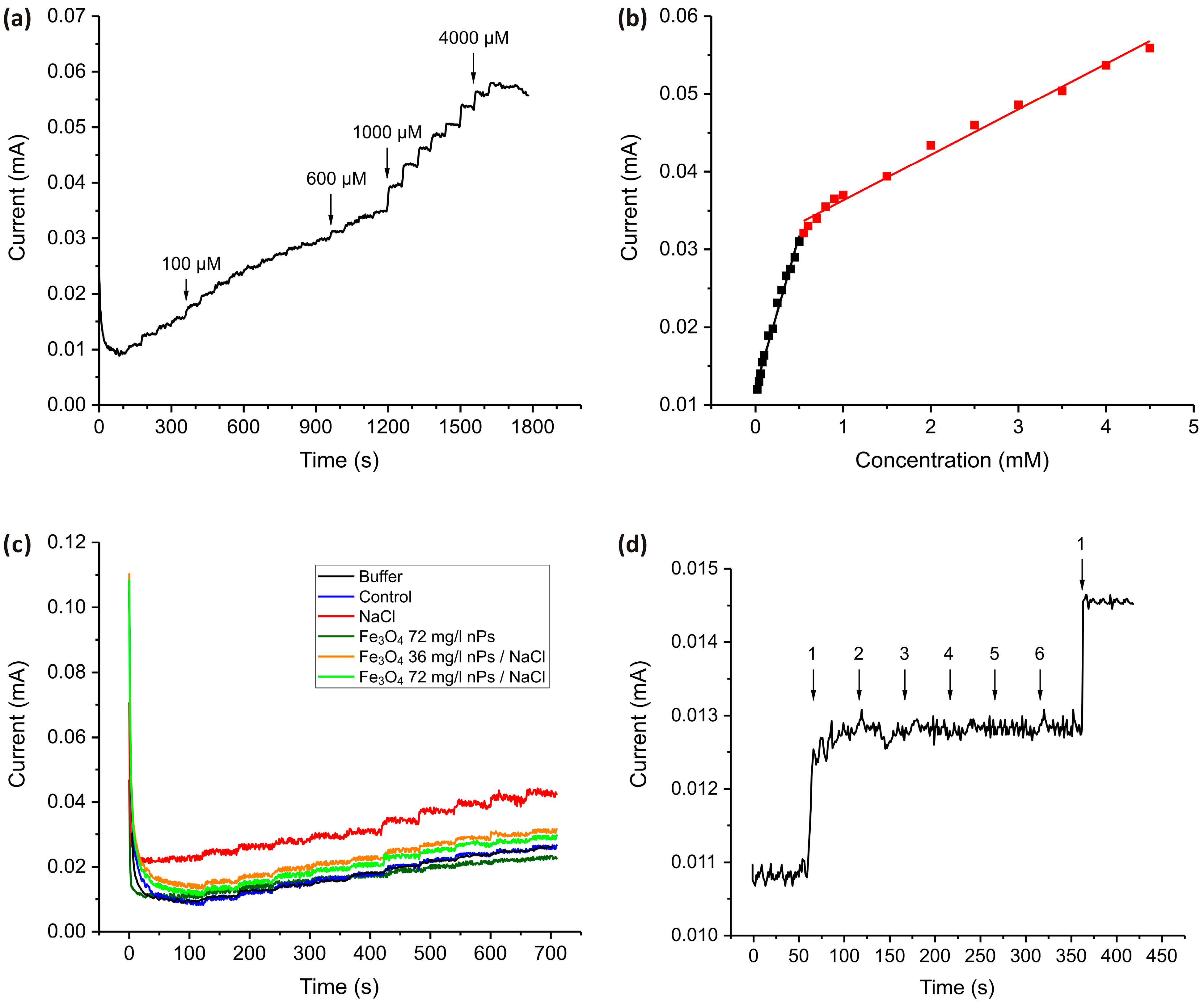
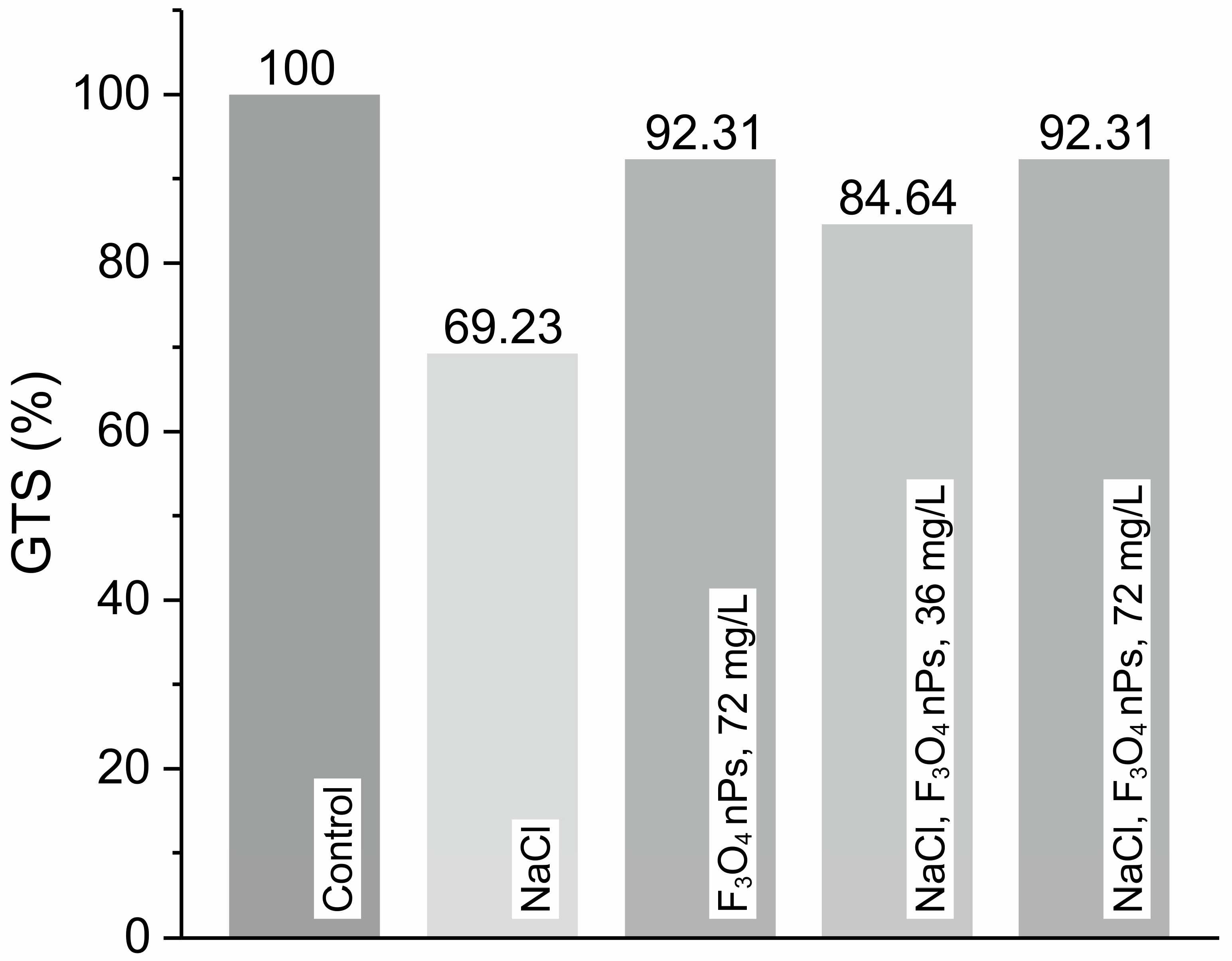
| Buffer | Control | NaCl | ||||||
|---|---|---|---|---|---|---|---|---|
| Added (mM) | Found (mM) | Excess (mM) | Added (mM) | Found (mM) | Excess (mM) | Added (mM) | Found (mM) | Excess (mM) |
| 0.02 | 0.02 | 0 | 0.02 | 0.02 | 0 | 0.02 | 0.34 | 0.32 |
| 0.04 | 0.04 | 0 | 0.04 | 0.04 | 0 | 0.04 | 0.38 | 0.34 |
| 0.06 | 0.06 | 0 | 0.06 | 0.055 | −0.005 | 0.06 | 0.4 | 0.34 |
| 0.08 | 0.08 | 0 | 0.08 | 0.08 | 0 | 0.08 | 0.44 | 0.36 |
| 0.10 | 0.1 | 0 | 0.10 | 0.1 | 0 | 0.10 | 0.47 | 0.37 |
| 0.15 | 0.15 | 0 | 0.15 | 0.2 | 0.05 | 0.15 | 0.55 | 0.40 |
| 0.20 | 0.2 | 0 | 0.20 | 0.22 | 0.02 | 0.20 | 0.68 | 0.48 |
| 0.25 | 0.25 | 0 | 0.25 | 0.25 | 0 | 0.25 | 1.45 | 1.2 |
| 0.30 | 0.30 | 0 | 0.30 | 0.296 | −0.004 | 0.30 | 1.67 | 1.37 |
| Fe3O4 nPs 72 mg·L−1 | Fe3O4 nPs 36 mg·L−1/NaCl | Fe3O4 nPs 72 mg·L−1/NaCl | ||||||
| Added (mM) | Found (mM) | Excess (mM) | Added (mM) | Found (mM) | Excess (mM) | Added (mM) | Found (mM) | Excess (mM) |
| 0.02 | 0.008 | −0.012 | 0.02 | 0.047 | 0.19 | 0.02 | 0.07 | 0.05 |
| 0.04 | 0.05 | 0.01 | 0.04 | 0.097 | 0.21 | 0.04 | 0.14 | 0.10 |
| 0.06 | 0.08 | 0.02 | 0.06 | 0.15 | 0.22 | 0.06 | 0.19 | 0.13 |
| 0.08 | 0.1 | 0.02 | 0.08 | 0.18 | 0.23 | 0.08 | 0.24 | 0.16 |
| 0.10 | 0.15 | 0.05 | 0.10 | 0.21 | 0.25 | 0.10 | 0.28 | 0.18 |
| 0.15 | 0.18 | 0.03 | 0.15 | 0.28 | 0.28 | 0.15 | 0.34 | 0.19 |
| 0.20 | 0.2 | 0 | 0.20 | 0.35 | 0.31 | 0.20 | 0.38 | 0.18 |
| 0.25 | 0.23 | −0.02 | 0.25 | 0.40 | 0.72 | 0.25 | 0.43 | 0.18 |
| 0.30 | 0.25 | −0.05 | 0.30 | 0.43 | 1.06 | 0.30 | 0.45 | 0.15 |
| Electrode | Supporting Electrolyte (pH) | Sensitivity | Linear Range | LOD | Reference |
|---|---|---|---|---|---|
| BOSe | PBS (pH = 7.4) | 75.7 μA·μM−1·cm−2 | 0–15 μM | – | [84] |
| GC/Chi-(CXBiFe-1050) | PBS (pH = 7) | 4.55 μA·mM−1 | 50–1000 μM | 2.5 μM | [85] |
| Bi2O3/MnO2 | (pH = 7.2) | 0.914 μA·μM−1·cm−2 | 0.2–290 μM | 0.05 μM | [86] |
| THP/SPCE | PBS (pH = 7.4) | – | 0–1000 μM | 0.14 μM | [87] |
| Pd/PTH@GCE | PBS (pH = 7.5) | 40.0 μA·mM−1 | 0.2–7.0 mM | 12.3 μM | [88] |
| LSG-Ag | PBS (pH = 7.4) | – | 0.1–10 mM | 7.9 μM | [89] |
| rROGO-S-Au HS/GCE | PBS (pH = 7.4) | 0.19 mA·mM−1·cm−2 | 5 μM–11.5 mM | 5 μM | [90] |
| TiO2 nW | PBS (pH = 7.4) | 0.0393 mA·mM−1 | 0–0.5 mM | 2.8 μM | This publication |
Disclaimer/Publisher’s Note: The statements, opinions and data contained in all publications are solely those of the individual author(s) and contributor(s) and not of MDPI and/or the editor(s). MDPI and/or the editor(s) disclaim responsibility for any injury to people or property resulting from any ideas, methods, instructions or products referred to in the content. |
© 2025 by the authors. Licensee MDPI, Basel, Switzerland. This article is an open access article distributed under the terms and conditions of the Creative Commons Attribution (CC BY) license (https://creativecommons.org/licenses/by/4.0/).
Share and Cite
Mihailova, I.; Krasovska, M.; Sledevskis, E.; Gerbreders, V.; Keviss, J.; Mizers, V.; Kokina, I.; Plaksenkova, I.; Jermalonoka, M.; Mosenoka, A. Hydrothermally Synthesized TiO2 Nanostructures for Electrochemical Detection of H2O2 in Barley (Hordeum vulgare) Under Salt Stress and Remediation with Fe3O4 Nanoparticles. Chemosensors 2025, 13, 256. https://doi.org/10.3390/chemosensors13070256
Mihailova I, Krasovska M, Sledevskis E, Gerbreders V, Keviss J, Mizers V, Kokina I, Plaksenkova I, Jermalonoka M, Mosenoka A. Hydrothermally Synthesized TiO2 Nanostructures for Electrochemical Detection of H2O2 in Barley (Hordeum vulgare) Under Salt Stress and Remediation with Fe3O4 Nanoparticles. Chemosensors. 2025; 13(7):256. https://doi.org/10.3390/chemosensors13070256
Chicago/Turabian StyleMihailova, Irena, Marina Krasovska, Eriks Sledevskis, Vjaceslavs Gerbreders, Jans Keviss, Valdis Mizers, Inese Kokina, Ilona Plaksenkova, Marija Jermalonoka, and Aleksandra Mosenoka. 2025. "Hydrothermally Synthesized TiO2 Nanostructures for Electrochemical Detection of H2O2 in Barley (Hordeum vulgare) Under Salt Stress and Remediation with Fe3O4 Nanoparticles" Chemosensors 13, no. 7: 256. https://doi.org/10.3390/chemosensors13070256
APA StyleMihailova, I., Krasovska, M., Sledevskis, E., Gerbreders, V., Keviss, J., Mizers, V., Kokina, I., Plaksenkova, I., Jermalonoka, M., & Mosenoka, A. (2025). Hydrothermally Synthesized TiO2 Nanostructures for Electrochemical Detection of H2O2 in Barley (Hordeum vulgare) Under Salt Stress and Remediation with Fe3O4 Nanoparticles. Chemosensors, 13(7), 256. https://doi.org/10.3390/chemosensors13070256






